Effective Ayurvedic Therapies For Low Back Ache
Article by Dr Raghuram Y.S. MD (Ay)
‘Low back ache’ – the name itself scares us all. It is a common health issue in the modern day life, so common that we are confused whether it is our friend or foe! Many of us have learned to live with it because we haven’t got the relief we were searching for. Every one of us would definitely suffer from low back pain at some point of our life but for many it accompanies for many years eclipsing smooth running of their day to day life.
For all those people ailing from an acute or chronic low back pain, Ayurvedic health science provides excellent remedies in the form of a number of time tested medicines and treatments.
Kati Shula (Low back pain), Kati Graha (Low back catch and discomfort), Trika Shula (Lumbo sacral pain) are the Ayurvedic terms for Low back pain.
In this write up, I am going to enumerate a list of treatments which provide outstanding and unparalleled relief in low back pain.
Below mentioned are the best Ayurvedic Treatment options for Low Back Pain.
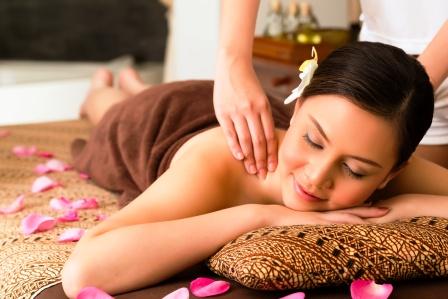
Table of Contents
External treatments
Bahya Chikitsa – External Ayurvedic treatments for low back ache:
Abhyanga
Abhyanga (Therapeutic / Preventive Herbal Oil Massage) –
Abhyanga means performing a massage. Massage of the afflicted part, low back area in case of low back pain and discomfort is done using herbal (medicated) oils. Medicated oil and mixture of medicated ghee is also preferred in some cases. Pain is generally caused due to aggravated Vayu / Vata. Taila (oil) is said to be the best remedy for vitiated Vayu. Massage not only alleviates the morbid Vayu but also provides significant relief from pain and catches. It nourishes and strengthens the bones, joints and soft tissues of the back and also rejuvenates them. Abhyanga when performed as a daily practice keeps up the health of low back while avoiding painful conditions even in the process of inevitable ageing. Ayurveda advocates whole body massage with herbal oils to be practiced on a daily basis.
Best oils used for Abhyanga:
Tila Taila (Sesame oil)
Ksheerabala Tailam
Mahamasha Tailam
Dhanwantaram Tailam
Murivenna
Pinda Tailam
Mahanarayana Tailam
Prabhanjana Vimardhana Tailam
Kottamchukkadi Tailam
Sahacharadi Tailam
Yashtimadhu Tailam
Guggulutiktakam Ghritam etc.
Samvahana, Mardana, Padaghata
Samvahana (light stroking with application of herbal oils) –
Samvahana is a variant of massage but in this case, pressure is not applied. Light stroking while applying the oil is done for a fixed period. The same oils used for Abhyanga is used for Samvahana.
Mardana (tapping while applying medicated oils) –
Mardana also can be said as a variant of Samvahana and Abhyanga. In this, light tapping is done with fists or palm after applying the herbal oils. This has an outstanding impact on pains and catches. It gives a very good relaxation.
Padaghata (Deep massage with foot) –
Padaghata is a unique type of Abhyanga, the only difference being massage done with foot instead of with hands as done in Abhyanga. Pressure applied with foot is more than pressure applied using hands. Padaghata can thus be preferred when deep tissue massage is needed. Padaghata done for low back can be a part of the treatment done for whole body or it can be independently done to attend low back pain. Padaghata is done after applying the oil liberally. It needs a lot of experience on the part of the masseur doing Padaghata. He should use the pressure skillfully. Providing relief is important. On the other hand, it is equally important to see that it is not overdone. Inexperienced masseurs and therapists on the other hand may seriously damage your back.
Swedana
Swedana (Fomentation / Sudation / Sweating therapy) –
Sweda means sweating. Swedana means a treatment procedure in which sweating is induced. Swedana is usually done after Abhyanga and or Snehana (administration of medicated oils and ghee for oral consumption in metered doses) as a pre-treatment procedure for cleansing treatments like Vamana – Therapeutic vomiting and Virechana – Therapeutic purgation).
We all know how relieved we feel after taking a hot water bath. Even after hot water bath, the body starts sweating, we feel lighter and energetic. The effect of sweating treatment taken after a soothing massage can be known only after having experienced it. After Swedana, the cells get activated and flush the toxins away. The cellular metabolism improves and we feel light and at ease.
There are many types of Swedana as explained in Ayurvedic texts. There are about 13 types of Sagni Sweda’s (sweat inducing treatments administered by procedures involving utilisation of fire or heated materials) and 10 types of Niragni Sweda (sweat inducing treatments where in the fire or heated materials are not utilized ex. sleeping covering thick blankets until we sweat etc). Every form can produce relief from low back pain. But the below mentioned types of Swedana are generally practiced –
Bashpa Sweda –
Bashpa means steam, Sweda means sweating therapy. This type of fomentation includes giving steam to the whole body after having administered a whole body massage. This is done especially when the low back pain is a part and parcel of poly-arthritis or any systemic disease or in back pains resulting from neuro-muscular or musculo-skeletal disorders.
The below mentioned are the variants of Bashpa Sweda which can be effectively used for the relief of Back Pain –
Sarvanga Bashpa Sweda – This is a steaming treatment conducted so as to cover the whole body. This can be preferred in low back pain when it is a part and parcel of a systemic disease or neuro-muscular or musculo-skeletal disorders. This is done by making the patient (who has been given a massage) inside a steam-chamber keeping his head out of the box, through an opening given for that purpose. After proper steaming, the patient is let out of the steam chamber or cabin.
Ekanga Bashpa Sweda or Nadi Sweda – Ekanga means one region or part of the body. This type is meant for partial fomentation. When the pain is limited to a part of the body like low back, knee joint etc, Ekanga Bashpa Sweda is preferred. This procedure is carried out by boiling pain alleviating drugs like Rasna, Eranda, Dashamula, Devadaru etc in a container with lid, say for example a pressure cooker. The nozzle of the cooker is connected with a heat resistant tube. When the contents in the vessel or cooker are boiled to optimum, the steam is released through the opening of the tube. The painful part is exposed to the steam.
Pinda sweda
Pinda Sweda (Bolus Fomentation) –
Pinda means bolus, Sweda means inducing sweating. Thus in Pinda sweda, the medicaments, generally hot or boiled to tolerable temperature are tied in a cloth so as to make a bolus. The bolus is gently rubbed over the low back area. Heat is provided until sweating occurs. Pinda sweda is generally done as a local fomentation, applied on the pain afflicted body parts. There are many variants of Pinda sweda, the name is given on the basis of the material / medicaments tied within the bolus. The best Pinda sweda’s in business are mentioned below –
Churna Pinda Sweda (Podikkizhi) – Churna means herbal powder, Pinda means bolus, Sweda means fomentation. As the name indicates herbal powders are filled and tied in a sterile cloth so as to form a bolus. The powder is used either in a dry form (high kapha-ama-meda conditions where rukshana or drying therapy is needed, presence of swelling and stiffness etc symptoms) or in wet form i.e. after frying the herbal powder in medicated oils (high vata-pitta conditions, presence of inflammatory and or degenerative changes, pain, burning sensation etc symptoms). The bolus is heated on a pan (dry fomentation) or dipped in pan consisting of oils (wet fomentation) before applying on the low back and rubbing it. After heating, the bolus is brought in contact with low back and gently rubbed in circular motion over joints and vertically over the muscles.
Note –
Ama means metabolic wastes created by low metabolism and indigestion which have a sticky nature and has a tendency to produce pain and stiffness.
Meda means fat.
Herbal powders used for Churna Pinda Sweda are:
Rasnadi Churna,
Kottamchukkadi Churna,
Jatamayadi Churna,
Ellumnishadi Churna,
Grihadhoomadi Churna,
Kolakulattadi Churna etc
Churna pinda sweda is done for 30-45 minutes
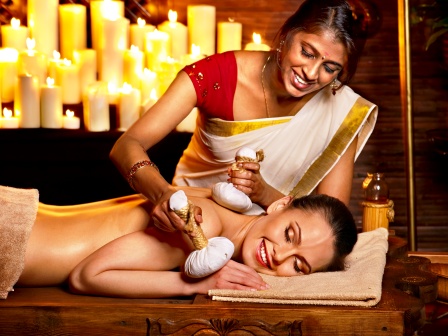
Patra Pinda Sweda – (Leaf bolus fomentation) – Patra means leaves of medicinal plants, Pinda means bolus, Sweda means fomentation. As the name indicates sliced (chopped) leaves of medicinal plants having anti-inflammatory, anti-degenerative and analgesic properties are filled and tied in a sterile cloth so as to form a bolus.
The fresh leaves of the Vata alleviating / pain relieving herbs are collected and sliced. Ex. Leaves of Eranda (Ricinus communis – castor plant), Nigundi (Vitex nigundo), Arka (Calotropis gigantean), etc are sliced. The sliced leaves are fried in herbal oil (oils used for Abhyanga). Grated coconut, sliced lemon, Rasnadi Churna, Haridra (Turmeric powder), Methika (fenugreek), Saindhava Lavana (rock salt), Eranda Taila (castor oil) are also added and fried. The sliced leaves are tied in a bolus to form a Patra Pinda (Leaf bolus). A couple of boluses are prepared
The leaf bolus is dipped in warm oil; temperature of the bolus is tested and used for giving fomentation. The bolus is rubbed on the affected part gently (as good as massaging with bolus). The procedure is repeated many times for a period of 30-40 minutes.
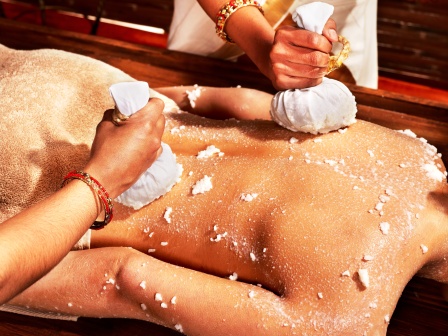
Shashtika Shali Pinda Sweda –
Fomentation with Shashtika Rice (rice grown in 60 days duration) processed with medicinal decoctions packed in boluses shall be preferred when there are signs of severe Vata vitiation and degeneration of tissues. The boluses are dipped in milk processed with pain alleviating decoctions and rubbed over the back continuously for 30-45 minutes. It rejuvenates, nourishes and strengthens the bones, muscles and soft tissues of the low back area.
Valuka Sweda – Valuka means sand, Sweda is sweat inducing treatment. In this treatment, the sand is heated to tolerable temperature and tied in a bolus. The bolus is heated in a pan. The heated bolus is continuously rubbed over the afflicted area, low back in this case. This treatment is preferred in the presence of ama (intermediate products of digestion and cell metabolism, circulating or tissue toxins which get adhered in the cells due to their sticky nature, block the channels and transport systems of the body and cause pain and stiffness) and symptoms of morbid kapha (stiffness, swelling, heaviness etc). Valuka Sweda is said to be unparalleled treatment in the systemic manifestation of Amavata (Rheumatoid arthritis).
Avagaha, Seka
Avagaha (Tub bath or Sitz bath) –
A big tub so as to accommodate the body of a person (like bathing tub) is filled with warm oils, ghee and oils, herbal decoctions and medicated (processed with medicinal drugs) milk. The patient who has low back pain is given a massage and made to sit in the tub for 40-35 minutes. The temperature of the liquid medicines is kept constant by re-heating the medicine. This treatment alleviates inflammation, degeneration and stiffness associated with pain in the back.
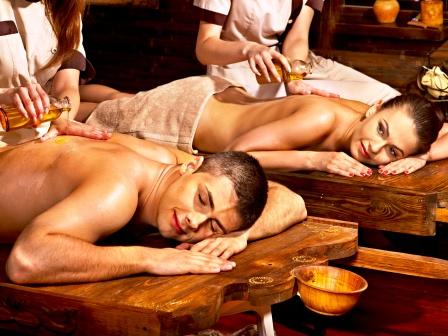
Dhara or Seka (Pizhichil) –
Dhara or Seka means to pour in streams. In this, medicaments including herbal oils and processed milk is poured in streams along with gentle stroking for a fixed duration. This is highly effective in combating morbid Vata, Pitta and Rakta in the low back areas.
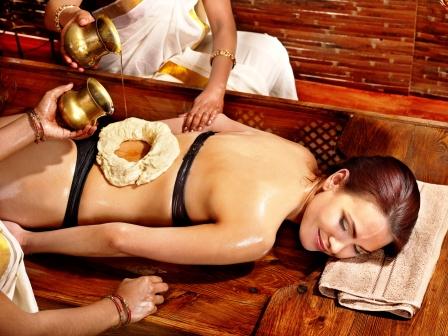
Kati basti, Kati pichu
Kati Vasti –
Kati means Low back (Lumbo-sacral region), Vasti means pooling or holding any liquid / fluid in a restricted place within a compartment or cabin constructed in that region.
Thus Kati Vasti means a treatment in which pain relieving warm medicated oils are poured and pooled for a fixed duration of time in a compartment or a cabin constructed over the low back area using wet flour of black gram, covering the Lumbo-sacral and Sacro-iliac joints.
In simple words, Kati Vasti is pain relieving oil-pooling treatment conducted for low back pain caused due to many causes
The temperature of the oil is kept constant. As the oil loses its temperature it is removed and replaced by warm oil. The procedure is carried out for 30-45 minutes. Kati Basti is a highly effective treatment for relieving back pain and discomfort. The constant contact of medicated oils with the afflicted area of the back helps in healing process. Kati Vasti combats not only pain but also catch, inflammation and degeneration effectively. It forms a highly effective combo with Pinda Sweda, especially Patra Pinda Sweda. Both are generally conducted together.
Read related: Kati Basti: Oil pooling Treatment For Low Back Pain
Kati-Pichu –
A larger piece of cotton swab (pichu) is dipped in medicated oil and ghee, kept in the affected area of the back and bandaged. It is left in place for a prescribed duration before it is removed. This is carried on day to day basis. This will continuously keep nourishing the bones, joints and tissues of the back, prevents degeneration, lessens inflammation, and heals pain and catches. The same oils used for Abhyanga can be skillfully used in this format of treatment also.
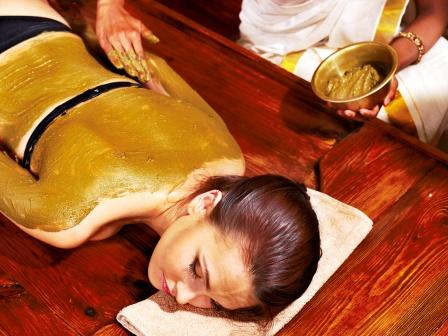
Kati lepa, kati upanaha
Kati Lepa –
Lepa means application. Powders of drugs which alleviate pain are made into paste. The paste is applied over the low back area. It is allowed to stay in place for a prescribed period of time or till the paste starts to dry. Depending on the disease and dosha involved, the Lepa is applied either hot / warm (vata, kapha vitiation) or cold (pitta, rakta vitiation). The common medicines which are used for Lepa are –
Rasnadi Churnam
Kottamchukkadi Churnam
Grihadhoomadi Churnam
Ellumnishadi Churnam
Dashanga Lepam etc
Kati Upanaha –
Upanaha means poultices. The same powders mentioned in lepa are used as medicaments in Upanaha. After mixing them with suitable medicated oils, salt etc. the medicines are applied and tied around the back such that the medicines lie in contact with the painful part for a prescribed duration until they are removed.
Internal treatments
Abhyantara Chikitsa (Oral Ayurvedic therapies for low back pain):
This includes some of the Panchakarma (5 treatment procedures which are used in body cleansing / detoxification) treatment procedures which should be skillfully chosen as per the condition of the dosha and the diseased.
Snehapana
Sneha means medicated oil or ghee, Pana means intake. Snehapana is a procedure in which the patient is made to drink metered doses of oils and ghee which are processed with medicines. This is given in 3 forms:
Shodana Sneha – Here the medicated ghee or oils are given in higher doses so as to cause saturation in the body. The dosage is increased every day until all the cells of the body get saturated or the symptoms of proper administration (Samyak Snigdha Lakshanas) are obtained or until the patient develops aversion towards the medicine. It is usually given early in the morning on empty stomach. It is given for patients for whom Shodana (body cleansing treatments like vamana – therapeutic emesis or virechana – therapeutic purgation) has been planned. After the body cells have been saturated with the Sneha, Swedana (whole body steaming) is given followed by administration of Vamana (therapeutic emesis) and or Virechana (Therapeutic purgation) is given.
Shamana Sneha – The same medicaments are given in smaller doses when the extent and strength of the disease and diseased are low or moderate. It is given when the patient feels hungry, before food. The intention is to pacify the vitiated Doshas and not to expel them.
Brumhana Sneha – The sneha is given for strengthening purposes and also for promoting bulk. The medicated oil or ghee is given mixed with food.
Nitya Snehapana – In this, small metered doses of Sneha is given on a daily basis either first in the morning or at bedtime usually mixed in hot milk or gruel. This method is followed when the patient is not able to take higher doses or is not fit for Panchakarma procedures. It acts as a lubricant and rejuvenates the joints and soft tissues of the low back. It also helps in tackling eh morbid Vata and Pitta which are causing backache.
Important medicines used for Snehapana –
Guggulutiktakam Ghritam
Tiktakam Ghritam
Indukantham Ghritam
Bala Tailam
Rasnadi Ghritam
Mahamasha Tailam
Brihat Chagaladya Ghritam
Amritaprasha Ghritam etc.
Virechana
Virechana means therapeutic purgation. Virechana is given after the administration of Snehapana and Swedana. Virechana expels the morbid dosha’s especially pitta and vata, thus preventing or curing the back related ailments caused by these morbid dosha’s.
Nitya virechana – This is a variant of Virechana where in the medicines which have a laxative property are given in low doses on a daily basis. This will target expulsion of morbid doshas on a daily basis, as and when they are formed and tending to cause some pathological changes in the low back area. Apart from expelling morbid vata and pitta, it also relieves pain, inflammation and stiffness of the back. This form of treatment has proved its worth in conditions like sciatica, lumbago, lumbar spondylosis and sacro-iliac joint disorders.
Best medicines used for Virechana (depending on the morbid dosha and morbidity):
Trivrit Leha
Sukumara Leha
Kalyana Gulam
Sukumara Ghritam
Gandharvahastadi Kashayam
Sukumaram Kashayam
Gandharvahastadi Eranda Tailam
Nimbamritadi Eranda Tailam
Higutriguna Tailam
Hingutriguna leham
Triphala Churnam
Narayana churnam etc
Basti
Basti –
Vasti means medicated enemas. Vasti or Basti is said to be the best treatment for vitiated Vayu, which is the chief culprit in pain games. When Vayu is controlled by the action of Vasti all the other disturbed body elements fall into rhythm and equilibrium. Vasti strengthens the tissues of the low back, rejuvenates health, aids fast healing and prevents recurrence.
Many times, constipation and accumulation of gases in the belly is the cause for back pain. Virechana and Vasti act as effective purgatives and relieve the mentioned conditions.
Vasti is given in the below mentioned forms:
Asthapana Vasti (Kashaya Vasti) – Herbal decoctions or milk (ksheera vasti) processed with decoctions is given as enemas.
Below mentioned are some of the best Asthapana Vasti’s in low back pain –
Erandamuladi Kashaya Vasti
Dashamula Kashaya Vasti
Dashamula Ksheera Vasti
Vaitarana Vasti
Mustadi Yapana Vasti etc.
Anuvasana Vasti – Medicated oils or ghee is used for enemas. It is given in combination with Asthapana Vasti (alternatively).
Matra Vasti – It is also a variant of Anuvasana Vasti but given in small doses. It can be given on a daily basis until the back related problems get resolved. Matra vasti lubricates the joints of the low back and relieves pain and associated conditions.
Best medicines used for Anuvasana and Matra Vasti are –
Guggulutiktakam Ghritam
Tiktakam Ghritam
Ksheerabala Tailam
Mahamasha Tailam
Sahacharadi Tailam
Brihat Saindhavadya Tailam
Bala Tailam etc.
Vamana, Udvartana
Vamana – Therapeutic Emesis (vomiting) is used in selected cases wherein symptoms related to morbid Kapha are seen.
Udwarthana – It is a treatment in which herbal powders either mixed or not mixed with medicated oils are rubbed against the body in an upward direction. It is a popular treatment and is an essential part of weight reduction and anti-obesity treatment packages. The treatment is said to mobilize and expel morbid kapha and meda (fat) responsible for causing blocks in the transport systems of the body. It is not a direct treatment for backache. Udwarthana helps because by eliminating morbid kapha and meda, it relieves the stress of body weight over the low back. Overweight and obesity often worsen low back pain.
Indications
Conditions of low back (which produce pain and related symptoms) in which the above said treatments are effective –
Low back pain (lower back pain / lumbago) – It is a common disorder of the lower back involving the muscles and bones of the back.
Sciatica / Lumbar Herniated discs – back pain (along with hip and outer side of the leg) caused due to compression of a spinal nerve root in the lower back, often owing to degeneration of an intervertebral disc.
Read related: Sciatica – Ayurvedic understanding and treatment
Lumbar Spondylosis – a degenerative osteoarthritis of the joints of the low back (lumbar vertebrae) between the center of the spinal vertebrae or neural foramina
Isthmic Spondylolisthesis – it occurs when a vertebra in the low back slips forward on the disc space below it. It is common at the L5-S1 level and can cause low back pain from instability and nerve root pain due to compression of the nerve root.
Lumbar spinal stenosis (degenerative spondylolisthesis) – In this there is pressure on the nerves at the point of their exit from the spine. Standing upright, such as in normal walking, increases pressure on the nerve and results in pain.
Spina bifida (occulta) – It is a birth defect where there is an incomplete closing of the backbone and membranes around the spinal cord. It presents with leg weakness and paralysis, club foot, hip dislocation, bladder and bowel control problems etc
Low back pain associated with –
Lumbar degenerative disc disease
Sacro-iliac joint disease
Piriformis syndrome
Fibromyalgia
Ankylosing spondylitis
Coccydynia etc.
Treatment combinations
Best Treatment combinations in low backache –
Many times we need to look at effectively combining the above said treatments so as to give a substantial relief and prevent recurrence. Of course maintenance is the key for non-recurrence post-treatment and it highly relies on the shoulders of the patients so as to how disciplined or not is their life-style after the treatment or treatment-combos are done with. The best combos in the business of pain relief are –
Kati Vasti and Patra Pinda Sweda
Abhyanga and Swedana
Abhyanga and Shashtika Shali Pinda Sweda
Kati Vasti, Pinda Sweda and Nitya Virechana
Virechana followed by Kati Vasti and Pinda Sweda
Virechana followed by Vasti along with Kati Vasti
Kati Vasti, Pinda Sweda and Matra Vasti
Kati Lepa or Upanaha with Nitya Virechana or Matra Vasti etc
To sum up –
Ayurveda has best remedies for low backache. Now that you are familiar with the wide range of options available to get rid of your back pain, all that you need to do is visit your nearest Ayurvedic doctor and ask for suitable remedies. He or she will be glad to help you out. Remember, your doctor is the best person who can take a call regarding what treatment suits you!
Also remember that it is not only the servicing but also a sincere maintenance which helps in enjoying the long time benefits of these treatments. So, in the first part it is the role of doctors in helping you out of the pains and discomforts and the second part totally belongs to you and how better you can take care of yourself!
Click to Consult Dr Raghuram Y.S. MD (Ayu)









